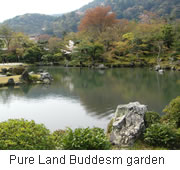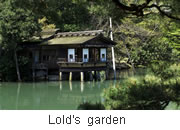What is a Japanese garden
Unlike western gardens, Japanese gardens are not symmetrical because the gardens aree relevant to nature. Nothing is symmetrical in nature.
Ponds, hills and green are coming from nature.
Also Religion, such as Shintoism, buddhism or tea ceremony have strong influence on Japanese gardens.
Types of Japanese garden
The landscape in Japanese garden
Japan has four seasons. The difference of the season is very clear, so each season has each face. Autumn suddenly comes after summer.
Japan has rainy season between spring and summer. The rainy season starts suddenly and it ends suddenly.
This multiple faces enable us to see the beautiful scene.
Japanese garden in each season
History of Japanese garden
I am unsure this section. This is what I learnt long time a go.
8th to 12 th century
 The nobilities have huge pond and hill garden. Gardens are surrounded by baronial mansion.
The nobilities have huge pond and hill garden. Gardens are surrounded by baronial mansion.
The Japanese oldest gardening book (stroll) was written in mid of 11th century. It tells do not conflict with nature, merge garden and nature, think about season etc.
Pure Land Buddhism style garden were built. They represent heaven of buddhism.
13 th century
Zen buddhism was introduced from China. The gardens were influenced by Zen.
14 th to mid 16 th century
Zen denomination has more power around this term. The Zen garden established the policy.
End of 16 th century
Tea ceremony was getting popular. Many tea gardens were created.
Samurai began to have strong power around this term. They enjoy tea ceremony in their tea garden.
17 th to mid of 19 th century
 From 1603 till 1868, Japan was a feudal period. The country was closed
From 1603 till 1868, Japan was a feudal period. The country was closed
Feudal lords had a big stroll garden. The big garden did not open to public.
The garden have pond, stream, tea house, or everything related with Japanese garden.
After 1868
Samurai period had finished. Feudalism ends and Japan was opened.
A lot of things were brought to Japan. The garden got westernised.
